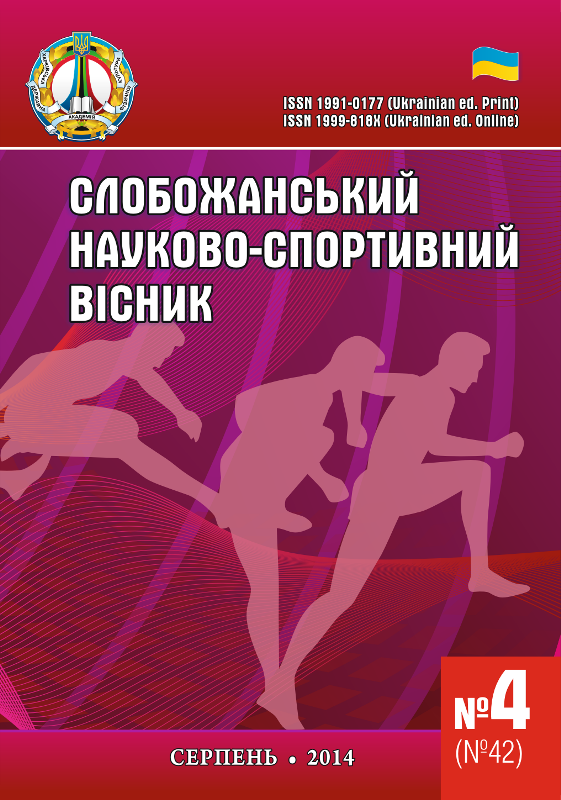The dynamics of the high-speed abilities of young players 12, 13, 14 years old
DOI:
https://doi.org/10.15391/snsv.2014-4.010Keywords:
speed, football, physical skill, specific and non-specific methodsAbstract
Purpose: to determine the dynamics of the high-speed abilities of young players. Materials and Methods: the change in performance of speed players at women's 30 meters run, using both specific and non-specific methods. In the training process of players 12–14 years to use specific tools, as well as holding athletic activities for the development of speed. The literature analyzed for the development of young players quickness, educational testing, methods of mathematical statistics. Results: the dynamics of development of physical skill of speed for young players using specific and non-specific methods. Conclusions: the use of the training process in microcycle preparatory period of athletics orientation training gives a positive result in the development of the physical speed quality.
References
Gerasimenko A. P. Sovershenstvovaniye osnov tekhniko-takticheskogo masterstva yunykh futbolistov [Improving fundamentals of technical and tactical skills of young football players], Volgograd, 2002, 156 p. (rus)
Kachalin L., Gorenskiy L. Trenirovka futbolistov [Coaching football], Moscow, Bratislava, 1984, pp. 22. (rus)
Kuznetsov A. A. Organizatsionno-metodicheskaya struktura uchebno-trenirovochnogo protsessa v futbolnoy shkole. I-y etap. (8–10 let) [Organizational and methodological framework of the training process in the football school. I-th stage. (8-10 years)], Moscow, 2007, 112 p. (rus)
Kuznetsov A. A. Organizatsionno-metodicheskaya struktura uchebno-trenirovochnogo protsessa v futbolnoy shkole. II-y etap. (11–12 let) [Organizational and methodological framework of the training process in the football school. II-nd stage. (11-12 years)], Moscow, 2007, 208 p. (rus)
Kuznetsov A. A. Organizatsionno-metodicheskaya struktura uchebno-trenirovochnogo protsessa v futbolnoy shkole. III-y etap. (13–15 let) [Organizational and methodological framework of the training process in the football school. III-th stage. (13-15 years)], Moscow, 2007, 312 p. (rus)
Kuznetsov A. A. Organizatsionno-metodicheskaya struktura uchebno-trenirovochnogo protsessa v futbolnoy shkole. IV-y etap. (11–12 let) [Organizational and methodological framework of the training process in the football school. IV-th stage. (11-12 years)], Moscow, 2007, 160 p. (rus)
Matveyev L. P. Teoriya i metodika fizicheskoy kultury [Theory and Methodology of Physical Education], Moscow, 1991, 543 p. (rus)
Monakov G. V. Podgotovka futbolistov. Teoriya i praktika [Preparing players. Theory and practice], Moscow, 2007, pp. 115–117. (rus)
Navchalna programa dlya dityacho-yunatskikh sportivnikh shkіl, spetsіalіzovanikh dityacho-yunatskikh shkіl olіmpіyskogo rezervu, shkіl vishchoі sportivnoі maysternostі [The curriculum for youth sports schools, specialized schools for children and youth Olympic reserve school high sports], Kyіv, 2003, 106 p. (ukr)
Perevoznik V. I. Slobozans’kij nauk.-sport. visn. [Slobozhanskyi science and sport bulletin], Kharkіv, 2011, vol. 4, pp. 79–84. (rus)
Romanenko V. A. Diagnostika dvigatelnykh sposobnostey [Diagnosis of motor abilities], Donetsk, 2005, p. 112, 122. (rus)
Downloads
Published
How to Cite
Issue
Section
License
Copyright (c) 2014 (Vladimir Perevoznyk) Перевозник Володимир Іванович

This work is licensed under a Creative Commons Attribution 4.0 International License.
Our publications make use of copyright CREATIVE COMMONS open access journals.
Authors published in this journal agree to the following terms:
1 The authors reserve the right of authorship of the work and pass the journal right of first publication of this work are licensed under the Creative Commons Attribution License, which allows others to freely distribute the published work with reference to the authors of the original work and the first publication of this magazine.
2 The authors have the right to enter into separate agreements for additional non-exclusive distribution of work in the form in which it was published the magazine (such as work place electronic repository institution or publish as part of the monograph), provided that the reference to the first publication of this magazine.

 Attention, authors!
Attention, authors!


